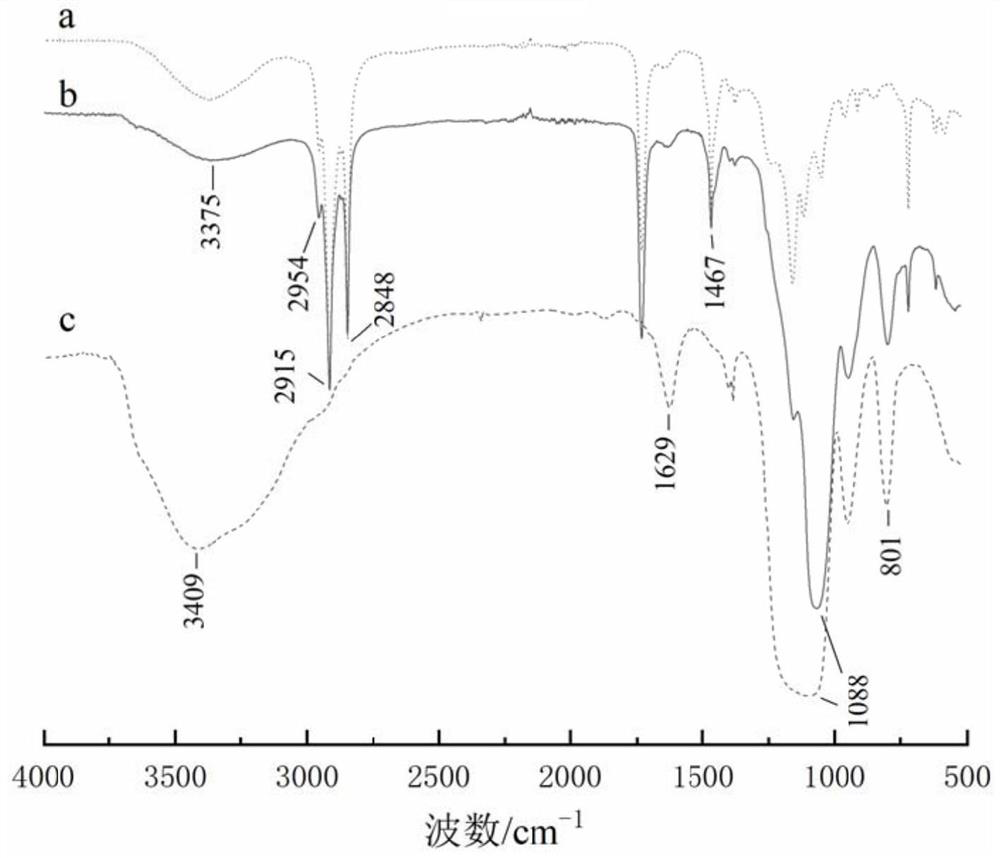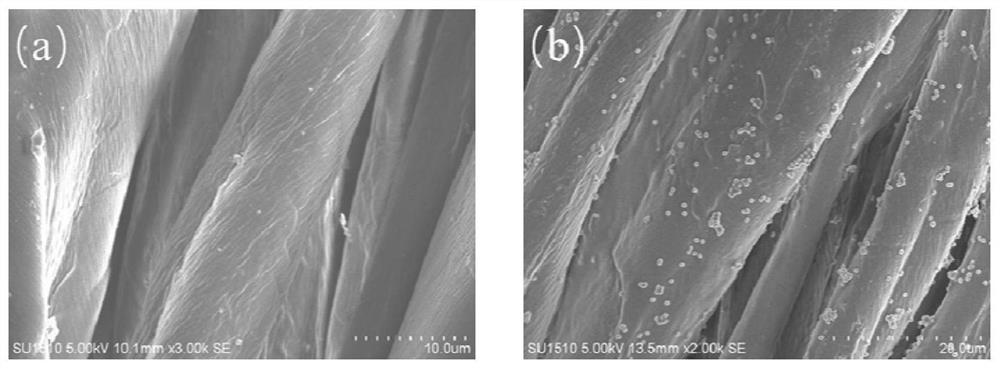Organic-inorganic nanoparticle composite water repellent, preparation method and application method thereof
A technology of inorganic nano-particles and water repellent, applied in textiles and papermaking, liquid-repellent fibers, wear-resistant fibers, etc., can solve the problems that silica is prone to agglomeration and cannot be uniformly dispersed
- Summary
- Abstract
- Description
- Claims
- Application Information
AI Technical Summary
Problems solved by technology
Method used
Image
Examples
Embodiment 1
[0080] A kind of preparation of organic-inorganic composite nano particle water-repellent agent, comprises the following steps:
[0081] (1) Nano silica double bond modification:
[0082] Preparation of nano-silica: Under magnetic stirring, tetraethyl orthosilicate is dropped into a round-bottomed flask containing a mixed solution of ammonia and ethanol with a constant pressure funnel, and the stirring reaction is continued at room temperature, and the reaction system turns white. , centrifuge the reacted silicon dioxide dispersion, get silica gel at the bottom of the centrifuge tube, add appropriate amount of absolute ethanol again, ultrasonically disperse, centrifuge again, repeat 3 times, and vacuum dry to get nano silicon dioxide. Among them, the volume ratio of tetraethyl orthosilicate, ethanol, and ammonia water is controlled to be 1:34:2.5, and the reaction temperature is 30°C, so that nano-silica with a uniform particle size distribution of 100 nm can be obtained. Dis...
Embodiment 2
[0097] A kind of preparation of organic-inorganic composite nano particle water-repellent agent, comprises the following steps:
[0098] Referring to steps (1) and (2) in Example 1, the corresponding surface tertiary aminated silica was prepared.
[0099] Quaternization of polymer brush grafted nano silica:
[0100] The tertiary amine polymer brush grafted nano-silica was ultrasonically dispersed in 3 times the mass of absolute ethanol, and the halogenated hydrocarbon 4-bromo-1-butene containing double bond structure was added for quaternization. The halogenated hydrocarbon and nano The mass ratio of silicon dioxide is 1:100, magnetically stirred and reacted for 4 hours, poured into a large amount of ether for recrystallization, filtered by suction, and dried in vacuum to obtain quaternized nano-silica containing double bonds.
[0101] Preparation of organic-inorganic nanoparticle composite water repellent by copolymerization:
[0102] 1) Take quantitative octadecyltrimethyl...
Embodiment 3
[0109] A kind of preparation of organic-inorganic composite nano particle water-repellent agent, comprises the following steps:
[0110] Referring to steps (1) and (2) in Example 1, the corresponding surface tertiary aminated silica was prepared.
[0111] Quaternization of polymer brush grafted nano silica:
[0112] The tertiary amine polymer brush grafted nano-silica was ultrasonically dispersed in 3 times the mass of absolute ethanol, and the halogenated hydrocarbon 5-bromo-1-pentene containing double bond structure was added for quaternization. The halogenated hydrocarbon and nano The mass ratio of silicon dioxide is 1:50, and the reaction is carried out by magnetic stirring for 6 hours, poured into a large amount of ether for recrystallization, filtered by suction, and dried in vacuum to obtain quaternized nano-silica containing double bonds.
[0113] Preparation of organic-inorganic nanoparticle composite water repellent by copolymerization:
[0114] 1) Take quantitativ...
PUM
| Property | Measurement | Unit |
|---|---|---|
| Particle size | aaaaa | aaaaa |
| Weft breaking strength | aaaaa | aaaaa |
| Water contact angle | aaaaa | aaaaa |
Abstract
Description
Claims
Application Information
 Login to View More
Login to View More - R&D
- Intellectual Property
- Life Sciences
- Materials
- Tech Scout
- Unparalleled Data Quality
- Higher Quality Content
- 60% Fewer Hallucinations
Browse by: Latest US Patents, China's latest patents, Technical Efficacy Thesaurus, Application Domain, Technology Topic, Popular Technical Reports.
© 2025 PatSnap. All rights reserved.Legal|Privacy policy|Modern Slavery Act Transparency Statement|Sitemap|About US| Contact US: help@patsnap.com



